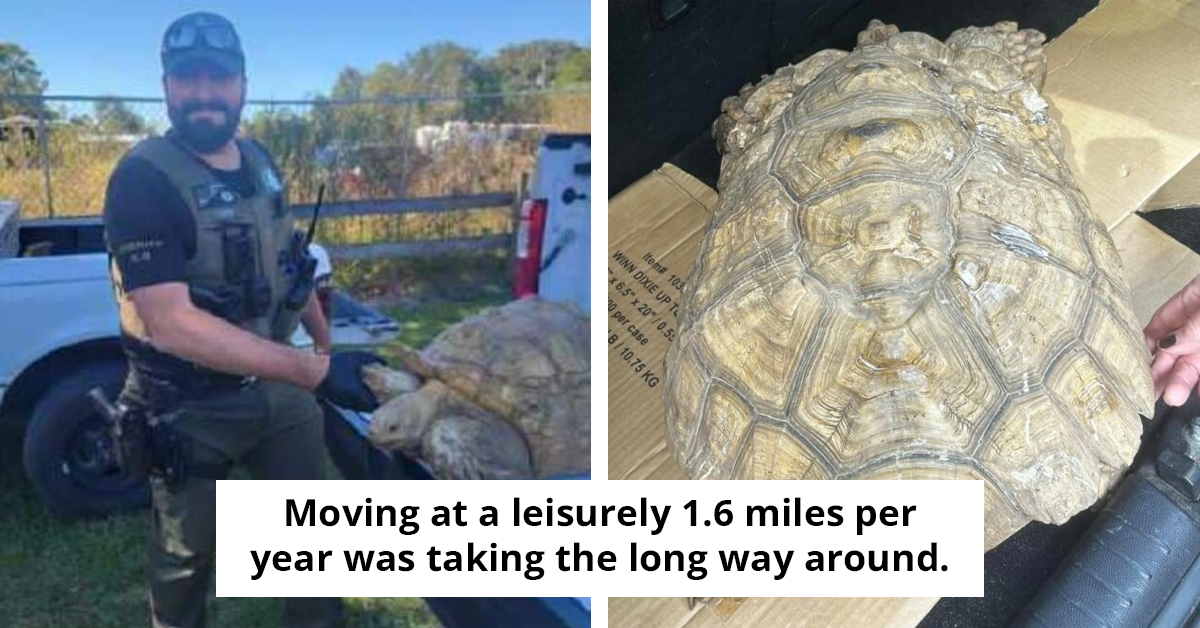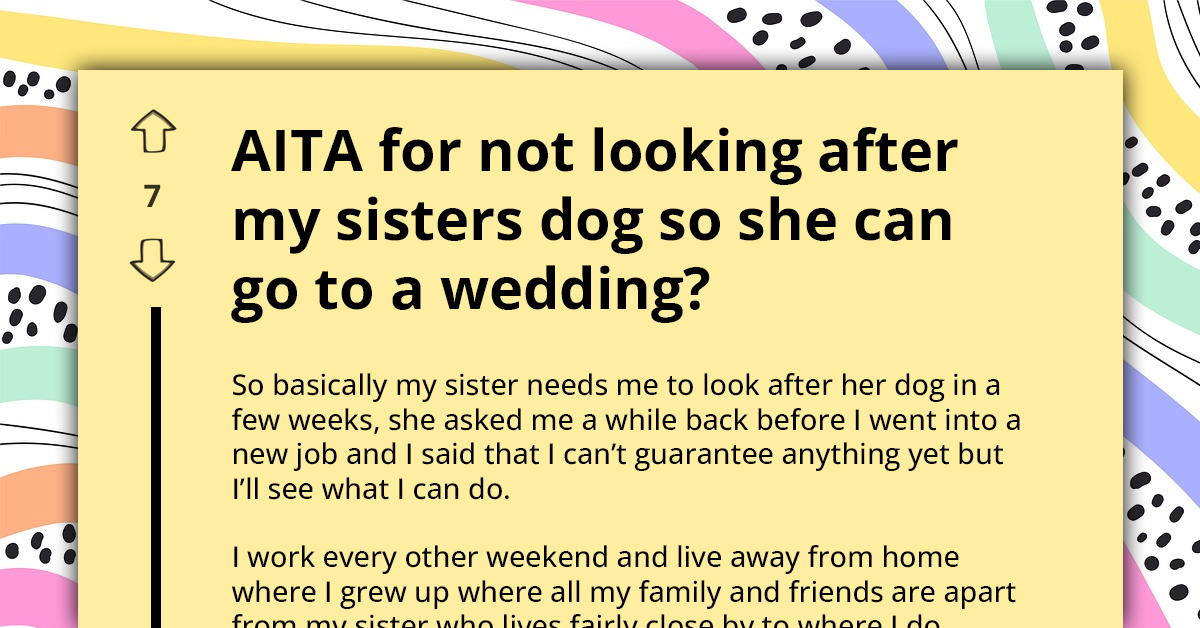Responsible Dog Owner Gets Attacked By A Woman Because His Dog Urinated On A Sidewalk Near Her House
Every dog owner has a responsibility and obligation to pick up after their dog. However, some things can’t be picked up.
The only thing you can do is try to control where they urinate, and it can be challenging sometimes because, basically, dogs pee on everything.
They use it to mark territory and leave information for other dogs… there is a whole science involved.
But let’s get back to the point. You can’t pick up after your dog when it pees, but you can limit its movements when you approach objects that you know might make it want to mark them.
The Redditor whose story we are showcasing today is a responsible dog owner, but he got attacked by an angry homeowner anyway.
“My wife and I recently walked our dogs and used our typical route, which passes by a house with a very nice but small manicured lawn. It's clear that the owner of this yard cares passionately for it, and we have complimented them once or twice while walking by. I usually try to heel the dogs closer to me for better control because usually around this part of our walk, my dogs need to poop, and I don't want them pooping in anybody’s yard.”
So, it is clear that this dog owner is responsible. This is what happened next:
“As we were passing this house, the lady (a middle-aged woman) was out doing yard work, and my big dog ended up urinating on a small pile of pine needles that had accumulated off of the sidewalk on the street next to this woman's lawn.”
Read the full story below:
OP asks:

He and his wife were walking their dogs. OP is always careful not to let their dogs do their business on people's lawns

They were passing one house with a beautiful lawn, and their dogs urinated on a pile of pine needles

Understanding Public Reactions to Pet Behavior
The incident involving a dog urinating near a woman's house highlights the social complexities surrounding public spaces and pet ownership. Dr. Karen L. McNulty, a social psychologist at Stanford, notes that public reactions often stem from individual beliefs about personal property and boundaries.
When individuals perceive a threat to their personal space or property, it can trigger defensive reactions, leading to heightened emotions. This response is particularly common in neighborhood dynamics, where social norms and expectations can clash.
The Role of Public Spaces in Animal Behavior
Public spaces often serve as a stage for the interplay between human behavior and animal behavior. The woman's reaction to the dog urinating near her house can be understood through the lens of environmental psychology. Research indicates that individuals often feel a sense of ownership or personal boundary over their immediate surroundings, which can lead to heightened sensitivity regarding perceived violations. This sense of territory is deeply rooted in our social and psychological constructs, suggesting that her reaction was less about the dog itself and more about her perception of control over her environment.
Understanding this can help both parties navigate their feelings and reactions more effectively in similar situations.
After a while, they were confronted by the house owner about the "incident"

OP was confused because he doesn't believe it is an incident
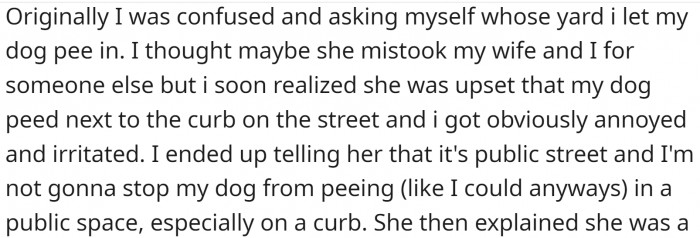
The woman explained she is a recent skin cancer survivor and that she was planning to pick up those pine needles from the street. Clearly, it is a health risk for her

Moreover, the emotional intensity of such reactions can be exacerbated by personal experiences. Research shows that individuals who have previously encountered negative experiences with animals or irresponsible pet owners may react more strongly in similar situations. This psychological pattern emphasizes the need for empathy in interactions between pet owners and community members.
Understanding the roots of such reactions can foster a more cooperative atmosphere, enabling neighbors to address conflicts more constructively.
This scenario also touches upon social norms surrounding pet ownership and public conduct. A study published in the Journal of Applied Animal Welfare Science suggests that societal expectations often dictate how pet owners should manage their animals in public spaces. The woman's strong reaction may stem from her belief that the owner should adhere to these norms, which can create friction between pet owners and non-pet owners. By recognizing the underlying social expectations, both sides can engage in more constructive conversations about acceptable behavior in shared spaces.
But OP is not clairvoyant, and she can use gloves or a shovel to pick up those needles.
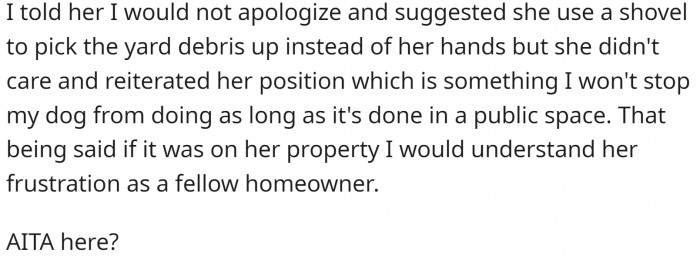
Redditors agree - dogs pee on things
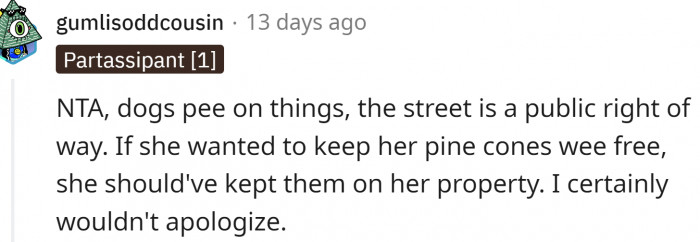
The neighbor was out of line

Navigating Neighborhood Conflicts
In navigating such neighborhood conflicts, communication is key. According to Dr. John Gottman's research on conflict resolution, approaching disputes with a mindset of collaboration rather than confrontation can lead to more positive outcomes. Pet owners should strive to engage neighbors in discussions about boundaries and expectations, which can help reduce misunderstandings.
For instance, setting clear expectations about pet behavior and responsibility can foster a sense of shared ownership in community standards, helping to alleviate tensions.
Exploring Communication Styles
Effective communication is crucial in resolving misunderstandings, especially in public disputes. Research from the University of Minnesota emphasizes that using non-confrontational language can help de-escalate tensions. In this case, the dog owner could have approached the woman with an understanding tone, acknowledging her feelings while explaining the nature of dog behavior. This approach could reduce defensiveness on both sides and promote a more productive dialogue.
Additionally, active listening plays a critical role in conflict resolution. By truly hearing the woman's concerns, the dog owner can demonstrate respect and empathy, which can foster a more amicable relationship moving forward.
It was not her lawn, but a public place near it

She chased them down... Sounds a bit...

Well, this was an interesting story. We understand that this woman is a skin cancer survivor and that touching that pile of pine needles might be dangerous for her health, but on the other hand, it was on a public sidewalk.
And she can use gloves or a shovel to pick it up. OP can’t really know the medical diagnosis for everyone on the street and the things to look out for.
From a psychological perspective, this situation can also be seen as a manifestation of anxiety about unpredictability in public settings. A clinical psychologist might explain that people often feel uneasy when they perceive a lack of control, especially regarding their environment. Research shows that individuals with high anxiety levels are more likely to react strongly to perceived threats in their surroundings. Understanding this can help the dog owner approach the situation with compassion, recognizing that the woman’s reaction may be rooted in her own feelings of vulnerability.
Practical Strategies for Conflict Avoidance
To prevent similar misunderstandings in the future, dog owners can take proactive measures to ensure their pets are well-behaved and that owners are aware of their surroundings. Training dogs in basic commands can provide owners with greater control, which can help ease the concerns of others in public spaces. Furthermore, pet owners might consider using designated areas for pet activities, reducing potential conflicts with non-pet owners. Research indicates that establishing clear boundaries in shared spaces can significantly enhance mutual respect and coexistence.
By fostering an atmosphere of understanding and cooperation, communities can create environments where both pets and residents feel comfortable.
Psychological Analysis
This incident illustrates a common tension between pet owners and those without pets, rooted in differing perceptions of public space and social norms. The woman's reaction underscores how anxiety about territory and social expectations can lead to conflict. Encouraging dialogue and understanding can help bridge these gaps, fostering a more inclusive environment.
Analysis generated by AI
Analysis & Alternative Approaches
Understanding the psychological dynamics at play in public interactions can help foster more harmonious relations between pet owners and non-pet owners. By focusing on effective communication, empathy, and proactive strategies, it’s possible to create shared spaces that respect the needs and concerns of all individuals involved. Research supports that such efforts lead to improved community cohesion and satisfaction.
Additionally, fostering community relationships can help mitigate future conflicts. Engaging in community events or pet-related gatherings can create opportunities for pet owners and neighbors to connect, fostering a sense of camaraderie. Research in community psychology suggests that building social ties can enhance mutual understanding and cooperation within neighborhoods.
By promoting positive interactions, pet owners can help normalize responsible pet ownership while addressing the concerns of community members.
Analysis & Alternative Approaches
In summary, understanding the psychological drivers behind public reactions to pet behavior can lead to more harmonious neighborhood dynamics. Recognizing that emotions often stem from individual experiences allows for more empathetic dialogues.
As emphasized in community psychology literature, fostering positive relationships within neighborhoods can significantly reduce conflicts and enhance community cohesion.
